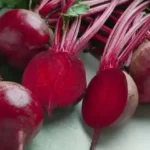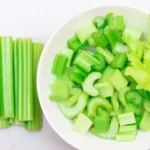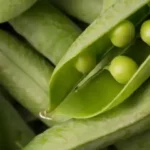You’ve harvested many delicious turnip greens but noticed other plants in your garden aren’t doing well, and there are bugs everywhere. As a backyard gardener, I understand that you feel frustrated by the unbalanced state of your garden. And you start to wonder if there is a way to get all the plants in the garden to thrive together. It’s time to discover the best companion plants for turnips and how they can work in your backyard garden.
Plant turnips with legumes to fertilize the soil, brassicas for similar growth conditions, aromatic plants to deter pests, and flowers like nasturtiums and marigolds to attract beneficial insects. Avoid alliums and herbaceous annuals like corn and sunflowers that require more space and skip tall, fast-growing plants that steal sunlight from lower-growing turnips.

Companion planting is like matchmaking for your garden and helps increase the success of your green friends. Pairing turnips with their perfect plant partners strengthens your garden, filling it with life and vigor.
In this article, you’ll learn how to create a resilient ecosystem where various plants work together, like pairing turnips with their foliage allies. Find out all these revolutionary secrets as you uncover everything there is to know to make your cultivation efforts blossom.
Humble Highlights
- Gain insights into the advantages of companion planting so you can create the perfect garden environment for your turnip patch.
- Explore the list of the best turnip companion plants to boost growth and protection so you can confidently cultivate delicious turnips.
- Discover the plants that don’t make friendly turnip neighbors so you can save money and time by organizing your garden for better harvests!
Benefits Of Companion Planting For Turnips
Companion planting is a gardening technique where gardeners grow different plants together for mutual benefit. Here are several benefits of companion planting with turnips.
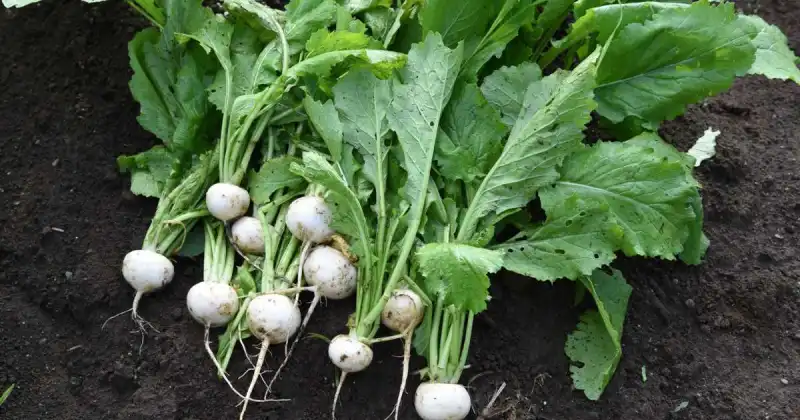
- Support, Shelter, and Nutrients: Companion planting is a practice that includes physical benefits such as taller plants providing physical support to climbing vines. It also creates a favorable environment for your plants by sheltering them from wind or harsh sunlight. Some plants can draw specific nutrients from the soil and make them available to neighboring plants, ensuring a balanced and thriving garden ecosystem.
- Pest Prevention: Companion planting is a natural form of pest control in organic gardening. Specific beneficial plants like rosemary emit scents or substances that deter common pests on the turnips. These plants can help promote a healthier and more environmentally friendly garden by replacing chemical insecticides.
- Attracting Beneficial Insects: Some flowers and herbs lure bees and butterflies, essential for pollination, thereby increasing yield and ensuring the propagation of various plant species. Additionally, certain plants attract predatory insects that prey on harmful pests, offering a natural defense that maintains the garden’s balance and health.
- Space Efficiency: Companion planting maximizes garden space, especially in urban or limited areas, by pairing plants that grow well together, enhancing productivity. It enables efficient use of resources like water, soil nutrients, and sunlight by aligning plants with complementary needs, resulting in a flourishing garden even in confined spaces. 1
What To Plant With Turnips: Best Companion Plants for Turnips
Turnips flourish when grown alongside specific companion plants, enhancing their growth and flavor and protecting them from pests. Here are some of the best turnip companion plants to consider:

Brassicas (Cabbage, Broccoli, and Cauliflower)
Since turnips belong to the Brassica family, they naturally get along well with other brassicas like cabbage, broccoli, radish, and cauliflower. Brassicas make good companions for turnips because they have comparable nutrient needs, often requiring similar levels of essential elements like nitrogen, phosphorus, and potassium. When grown near your turnips, brassicas don’t compete intensely for specific nutrients in the soil, as they have shared demands.
Additionally, brassicas often have diverse growth habits. For example, turnips are grown for their underground bulbs, broccoli forms its distinctive florets, and cabbage develops its tight head.
This diversity means that different parts of the soil and space are utilized, reducing competition for root space and light. This compatibility minimizes competition for essential nutrients and space, creating a balanced ecosystem. 2
Legumes (Peas and Beans)
Legumes like beans, clover, and peas are nitrogen-fixing plants. Legumes establish a unique connection with rhizobia, a soil bacteria that assists in a fascinating process called symbiotic nitrogen fixation (SNF).
This symbiotic process grants legumes a steady nitrogen supply, which they release into the soil that other plants, like turnips, enjoy. This relationship makes the soil healthier and helps plants grow without needing as much manufactured plant food, making excellent turnip companion plants.

Aromatic Plants (Sage and Rosemary)
Aromatic plants like dill, celery, sage, peppermint, and rosemary make good companion plants for turnips. They help deter pests like aphids and flea beetles, which can cause catastrophic damage to turnip leaves. The pungent aroma of these herbs acts as a natural repellent while adding a layer of protection for your turnip plants.
Moreover, aromatic plants have the remarkable ability to root maggots, which threaten turnip plants. Root maggots are troublesome pests as they are the larvae of various fly species and can inflict damage by feeding on the turnip roots. 3
When planted near your turnip patch, these aromatic plants release fragrances that displease adult flies, causing them to be deterred from laying their eggs near the roots of the turnip plants. As a result, the turnips are shielded from potential root maggot infestations, leading to a healthier and more successful crop.

Nasturtiums And Marigolds
Nasturtiums and marigolds make great companion plants for turnips. These flowering plants not only add a touch of aesthetic beauty to your garden but also serve as natural pest repellents. Nasturtiums, in particular, can deter aphids and caterpillars, while marigolds emit a scent that repels various pests, whiteflies, and nematodes, which makes them fantastic buddies for turnips. 4
Aside from the apparent benefits previously mentioned, these beautiful blooms also attract beneficial insects like hoverflies to your turnip patch that help maintain a balanced and healthy garden ecosystem. While these helpful insects aid in pollination, their tiny larvae act as willing predators, searching the leaves of your plants for common pests like aphids.
Maximizing your turnip harvest with companion planting comes down to a little organization before sowing. Remember, turnips enjoy unobstructed sunlight and flourish in cool conditions and moist soil, so growing them alongside like-minded veggies with the same growth habits is a sound practice. Check out the video below, which offers some excellent companion options!
What Not To Plant With Turnips: Bad Companion Plants
There are very few plants considered bad companions for turnips. These are some of the unsuitable plants to grow alongside turnips.
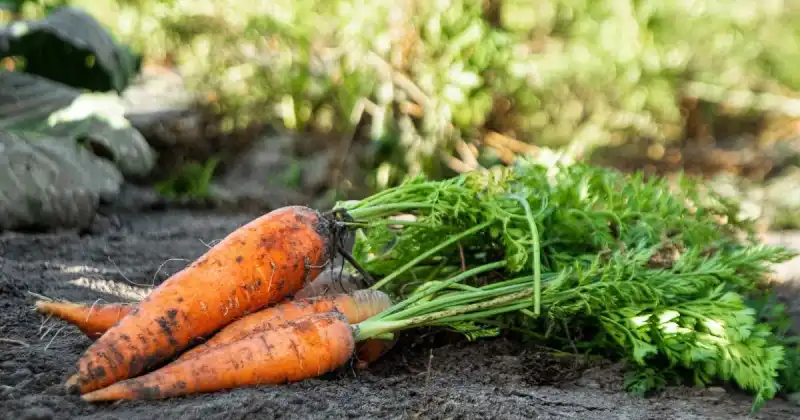
Root Vegetables
Regarding companion planting, some combinations of plants don’t work well together, and root vegetables are a prime example. Like other root vegetables, turnips rely heavily on their deep and penetrating root systems to absorb nutrients and water from the soil.
Root vegetables such as carrots, beets, potatoes, and parsnips, just like turnips, have an affinity for growing their roots deep into the soil to access resources. However, planting root vegetables next to turnips can lead to competition for space and nutrients in the ground. 5
These crops are vying for the same limited pool of essential macro-nutrients like nitrogen, phosphorus, and potassium. As they compete for these resources, neither plant may receive an adequate share, leading to stunted growth and underdeveloped yields for turnip crops and other root vegetables.

Alliums
Allium plants like wild garlic and onions have allelopathic properties. Allelopathic properties refer to the ability of certain plants to release chemical compounds into the environment that can influence the growth and development of other nearby plants.
Allium plants release substances that can stop seeds from sprouting and young plants from growing. These substances come from the bulbs and leaves of the allium plants. The same substances are also found in the soil under these plants, making this a potential challenge if you plant turnips near allium species.
Remember, since gardeners grow turnips mainly for their roots, the adverse effects of allium plants stopping turnip seeds from growing could make it difficult for turnip roots to develop properly. If this happens in your backyard garden, you’ll likely notice reduced turnip yields. Keeping alliums and turnips on different sides of your green space is best.
Herbaceous Annuals
Steer clear of herbaceous annuals like corn and sunflowers when planting with turnips. These plants need more growth space and can cast shadows over turnips, blocking sunlight.
For example, corn and sunflowers are tall and proliferate, competing with turnips for sunlight, ultimately affecting turnip growth and overall health. Choosing plants that won’t hog space or sunlight ensures turnips have enough room to thrive and receive the sunlight they need for proper growth.
Understanding What Grows Well With Turnips
Turnips grow best in cooler weather. The best time to plant turnips is in spring and fall. They need mild temperatures and well-drained soil with plenty of organic matter so the roots can develop properly for healthy growth. This combination of factors helps the turnips reach their highest quality, giving you abundant harvests with great taste.
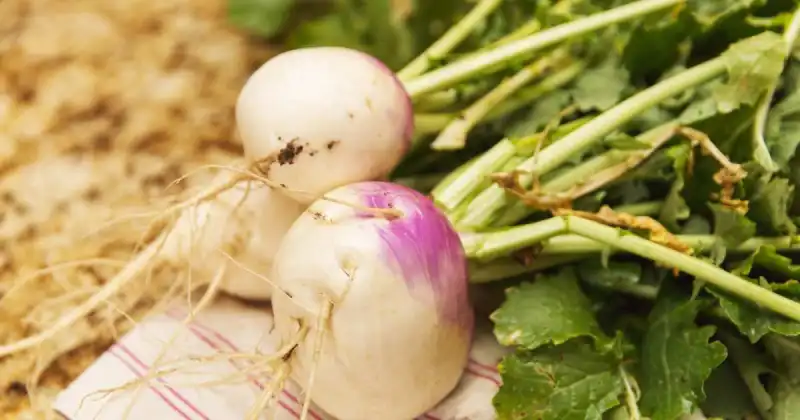
When growing turnips, selecting companion plants that prefer cooler temperatures and well-drained soil is best. That way, the garden will be where all the plants can grow and produce their best yields. Remember, when two compatible plants are grown together, they create an environment where each of them can reach their full potential. 6
Conclusion
Companion planting offers excellent advantages for turnips. Knowing which crop makes a good companion can help turnips grow better and deter pests naturally. Cabbage, broccoli, peas, beans, aromatic herbs, and colorful flowers like marigolds and nasturtiums enjoy harmonious and fruitful pairings with turnips.
However, it’s important to avoid planting certain crops that might compete for nutrients, such as other root vegetables and alliums. By understanding these dynamics, you can create a thriving and balanced garden that benefits turnips and other neighborly plants.
What do you currently sow next to your turnips? It could be one that made our list or another one entirely. We’d love to hear about your success. Take a moment now and leave a comment below!
SOURCES
- National Library Of Medicine, National Center For Biotechnology Information – Application Of Trap Cropping As Companion Plants For The Management Of Agricultural Pests: A Review
- University Of Minnesota, Extension – Growing Turnips And Rutabagas In Home Gardens
- ResearchGate – Effect Of Different Plant Spacing On The Production Of Turnip (Brassica rapa L.) Under Agro-Climatic Conditions Of Swabi (Pakistan)
- Almanac – Turnips
- Backyard Gardeners Network – Turnip Companion Plants – The 15 Best And 7 Worst Plants
- Royal Horticultural Society – How To Grow Turnips

